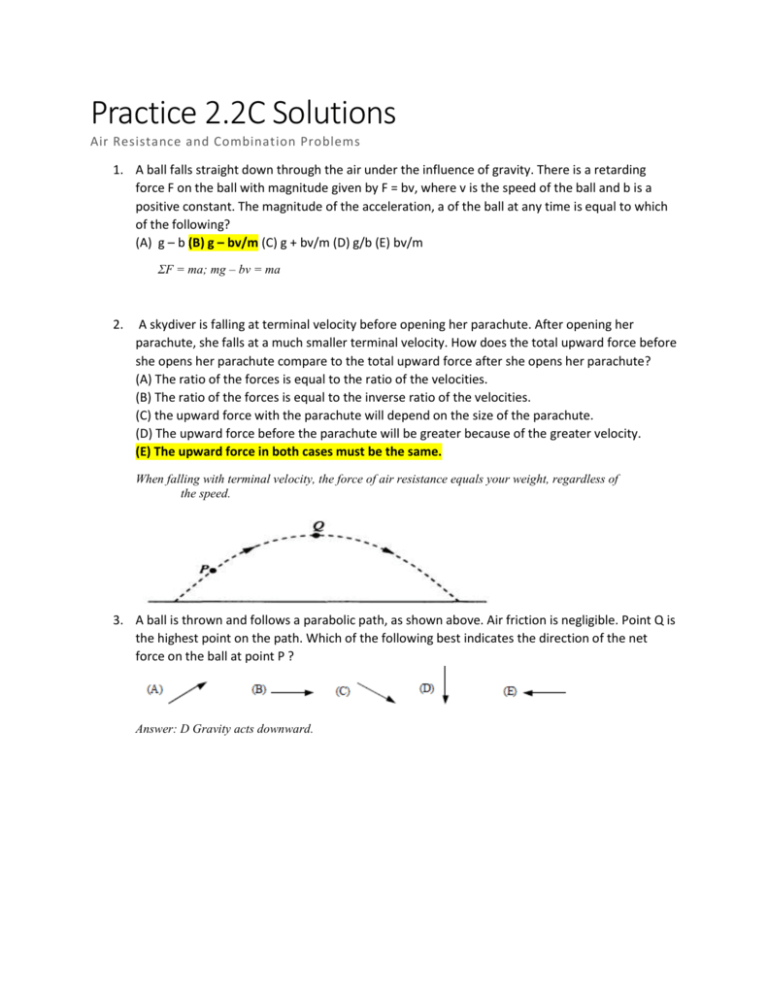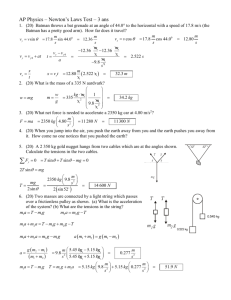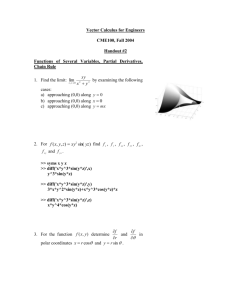File
advertisement

Practice 2.2C Solutions Air Resistance and Combination Problems 1. A ball falls straight down through the air under the influence of gravity. There is a retarding force F on the ball with magnitude given by F = bv, where v is the speed of the ball and b is a positive constant. The magnitude of the acceleration, a of the ball at any time is equal to which of the following? (A) g – b (B) g – bv/m (C) g + bv/m (D) g/b (E) bv/m ΣF = ma; mg – bv = ma 2. A skydiver is falling at terminal velocity before opening her parachute. After opening her parachute, she falls at a much smaller terminal velocity. How does the total upward force before she opens her parachute compare to the total upward force after she opens her parachute? (A) The ratio of the forces is equal to the ratio of the velocities. (B) The ratio of the forces is equal to the inverse ratio of the velocities. (C) the upward force with the parachute will depend on the size of the parachute. (D) The upward force before the parachute will be greater because of the greater velocity. (E) The upward force in both cases must be the same. When falling with terminal velocity, the force of air resistance equals your weight, regardless of the speed. 3. A ball is thrown and follows a parabolic path, as shown above. Air friction is negligible. Point Q is the highest point on the path. Which of the following best indicates the direction of the net force on the ball at point P ? Answer: D Gravity acts downward. Free Responses Problem 1 (a) On the figure below, draw and label all the forces on block m1. N T N f T f m g sin 1 m1g m1g Note: it is not necessary to show the component of the weight vector (m1g sin ) that is down the ramp (as seen on the drawing on the right. Express your answers to each of the following in terms of m1, m2, g, , and f (a) Determine the coefficient of kinetic friction between the inclined plane and block 1. f N f N f m1g cos (b) Determine the value of the suspended mass M that allows blocks 1 and 2 to move with constant velocity down the plane. m2 g sin T1 T2 2 f 0 m1g sin T1 f 0 T2 Mg 0 Add together: m1g sin T1 f m2 g sin T1 T2 2 f T2 Mg m1g sin f m2 g sin 2 f Mg M m1g sin m2 g sin 3 f g m1g sin m2 g sin 3 f Mg 0 g sin m1 m2 3 f g m1 m2 sin (c) The string between blocks 1 and 2 is now cut. Determine the acceleration of block 1 while it is on the inclined plane. FX ma m1a m1g sin f m 1 f M1 g sin a m1g sin f m1 g sin f m1 3f g 2. Two 10.0 kg masses are hanging from the ceiling of an elevator that is accelerating upward at 2.00 m/s2. What is the tension in each rope? T1 T2 T2 m g 1 F y m g 2 ma m1a T1 m1g T2 m2a T2 m2 g m m m2 a g 10 kg 2 2 9.8 2 s s T2 m2 a m2 g m1a T1 m1 g T2 T1 m1 a g T2 118 N m m 10 kg 2 2 9.8 2 118 N s s 236 N 3. A 250.0 kg crate is being pulled across the floor with a rope that makes an angle of 22.0 to the horizontal. If the force applied is equal to 875 N, what is the coefficient of kinetic friction? 8 7 5 N 2 5 0 .0 k g F y 0 n n F sin mg 0 m n 250.0 kg 9.8 2 875 N sin 22.0o 2122 N s x 0 n F cos Fsin f n mg F sin F 2 2 .0 F cos f 0 m g f F cos F cos n 875 N cos 22.0o 2122 N Fco s 0.382







